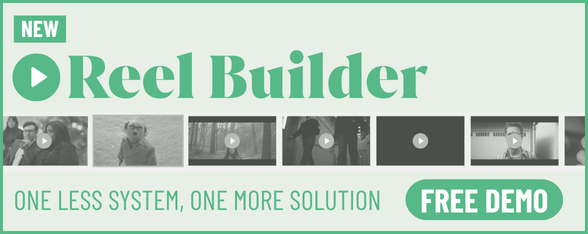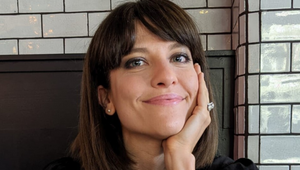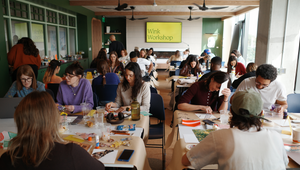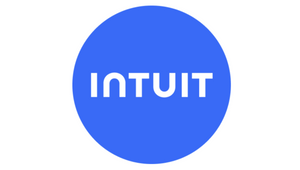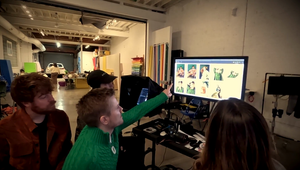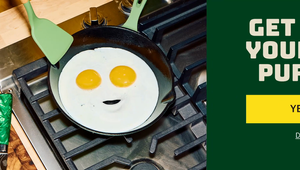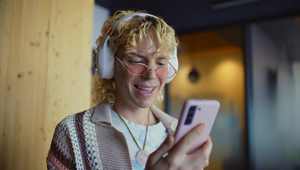
Inside Mailchimp's Email Utopia: Bringing the Future to Life in London
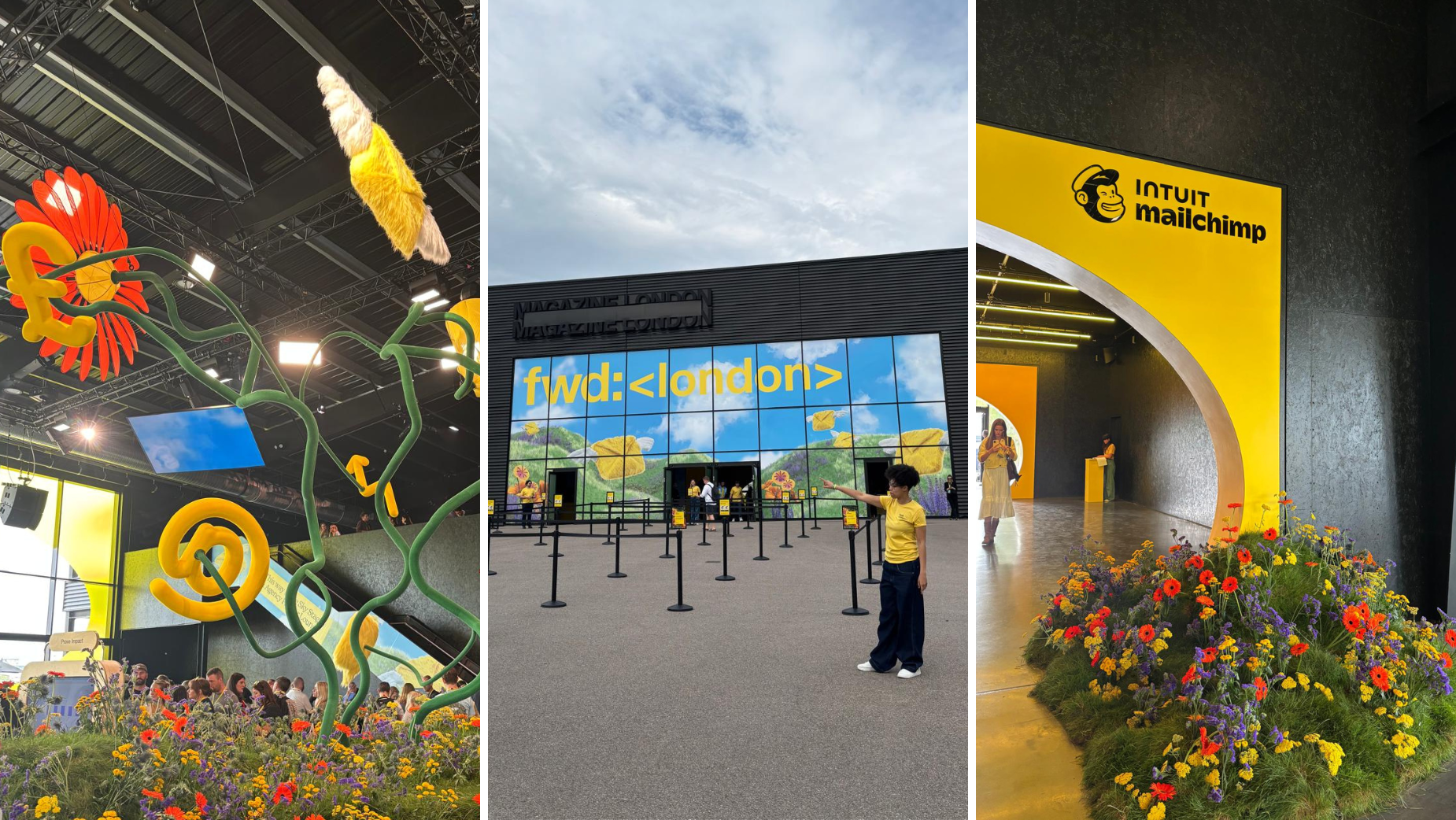
On June 12th, Mailchimp brought London’s marketers together at its annual conference, FWD: <LDN>. Far from a typical stuffy, greyscale marketing conference, attendees were offered a taste of the future. An email ‘utopia’ if you must.
Hosted at Magazine in London, the building was decked-out in Mailchimp’s typical vibrant yellow hue, and once inside, the bold colours bloomed. Furnished with trees, rolling hills and real flowers, the environment encouraged guests to think outside the rigidity of a typical email inbox, and instead imagine what an idealistic email world could look, sound, and even smell like.
The day began with an address from Leigh Thomas, vice president of EMEA at Intuit, who joined the organisation 7 months ago. She spoke of Intuit’s investment in AI, and the company’s intention to “transform how we get work done.” Leigh was followed by Intuit Mailchimp’s director of product marketing, Jamal Miller, who highlighted the pace and scale of innovation underway at Mailchimp, which has released over 2000 updates since the start of the year. He shared that in the UK, marketers sent over 27 and half billion emails in 2024 alone, with Mailchimp providing an “essential bridge” that connects tools and platforms.
For the rest of the day the stage was filled by speakers including advisor and author Dela Quist, sports influencer Joe Wicks, presenter and founder of Happy Place Fearne Cotton, TV personality and co-founder of Candy Kittens, Jamie Laing, amongst others.
In addition to the discussions taking place on-stage, guests could ‘gameify’ their experience, by exploring the space and collecting QR codes to unlock prizes such as recommended books or a personalised perfume courtesy of ‘Scent from Inbox’.
To find out more about how the forward-facing event came to life, LBB’s Abi Lightfoot and Olivia Atkins caught up with Jeremy Jones, global head of creative at Mailchimp’s in-house agency, Wink, on the ground.

LBB> You run this event internationally. How did Mailchimp’s FWD event land here in London?
Jeremy> At Intuit Mailchimp, we run an annual marketing conference, and for this year's theme, our in-house team at Wink wanted to focus more on email – the power of email, AI, and the future of marketing.
But when people think of ‘the future’, it can feel a bit scary. AI often comes across as dark or even a little creepy, so we built this idea of a utopia. What if the future could actually feel happy, interesting or thoughtful, and be something that really makes you think? Even though this is a ‘future’ experience, everything here is designed to feel very grounded. From the sound design to the environment, we’ve brought in natural elements like grass, flowers, and the idea – with a quirky twist – to create the sense that ‘if you ask ChatGPT to create a world’, it might look and feel like this vibe, while being real and also soothing.
It started with the question: ‘What does the future of email marketing look like?’ And we created a world around that and made the space feel thoughtful, so marketers could come and be immersed and notice that it was intentionally designed for them. Growth is core to Mailchimp, but we also like to weave in some entertainment value.
LBB> And how was the London event differentiated from other regions?
Jeremy> We were just in Sydney, where we ran the event on a much smaller scale, but it was there where we realised the opportunity of having half of the event outside and inside. Marketers are inside buildings all day, so if they're going to get a day out, we don't want them to still be locked up. It was at an earlier London event when we held half the event outside and the other half inside, meaning that marketers could experience activations during the day and still view the Thames in the background.
As the landscape shifts and marketers evolve in their thinking, we’re anticipating that the events will have to shift, too. The UK and Australia are two of our biggest growth markets, where we have salespeople and marketers on the ground. We’re focused on building our presence in these markets because more than half of Mailchimp’s business is outside of the US. Hosting events like this means we can actually speak to people one-on-one.
LBB> The space here is full of movement, similar to the ‘Pop Up Like It’s Hot’ campaign you did recently, can you tell us a bit more about the design system at play here?
Jeremy> With our design system, made up of dynamic and core elements, events like this lean into the dynamic side. You’ll see a lot of similar elements like Freddie Bounce (our mascot, inspired by the wink in our logo), but they’re brought to life in a much more expressive way, such as motion design, flying through clouds and whimsical creatures born out of feathered emails and sales boxes.
It has a playful Dr.Seuss vibe, but it's still part of the same system. It's all connected and the brand colours are the same, just they’re more animated. That's why when the ‘Pop Up Like it’s Hot’ video plays in this world, it still feels like us and resonates.

LBB> You’ve been with WInk since its inception – almost five years ago. Tell me how it launched and developed and how closely it works with the wider brand?
Jeremy> Wink is Mailchimp’s in-house creative agency. We do everything and are fully embedded into the marketing team, so we see things upstream. We’re not just making creative – we're solving business problems. Now, Wink has expanded to take on more work across the Intuit family of brands – QuickBooks, Mailchimp, and now the Intuit brand itself. So Wink is growing and evolving.
One of the hardest things is how fast the tech world moves. New parts of the business constantly emerge, so we’re always creating new teams and new team lifecycles. Wink started as more of a design and advertising team, but now it’s blossomed into something more like a full-service consultancy and creative production company.
One of the biggest shifts is that we’re becoming more integrated with product teams, too. Our design work is starting to influence how the product looks and feels in the world.
LBB> And how do you integrate the educational elements of events like FWD: <LDN> into the designs that you create at Wink?
Jeremy> We move into showcasing the product, we lean more into the core side of our design system. It's about showing just how useful, simple and easy the product is to understand.
Events like these are often centered around announcing new features or updates, so we're conscious that while we might have a more playful ‘wrapper’, the core messaging should still land and people should walk away understanding what the product is. It's still rooted in our brand, just with a little Wink.
LBB> And if it’s not for announcing a whole new product, what is the value for Mailchimp, of hosting events like FWD: <LDN>?
Jeremy> One of the best parts of these events is connecting one-on-one, hearing people’s user experiences and answering questions. A lot of the product updates we made this year – around 2000 of them – have been directly shaped by feedback from sessions like today or through online conversations. Getting face-to-face time is really valuable. Usually, we’re behind computer screens, so having a full day dedicated to talking to partners, agencies and customers really helps us build better.

LBB> Why is Wink well positioned to design and put together events like Fwd: <LDN>, after all, people might not expect an email platform like Mailchimp to be so active in the experiential space?
Jeremy> What's interesting is that at Mailchimp, we're marketing marketing to marketers. And yet, most marketing conferences can feel quite stiff, which is why we wanted this one to have different energy. Especially because it's about email – which can be labelled as boring, bottom-of-the-funnel or just another sales tactic.
With that in mind, we wanted to show the fun side of email. To prove that it has personality. Email is a crucial part of marketing but it’s rarely seen as unique, special, or capable of building a brand. That’s where Wink comes in. It’s designed to bring email’s fun side to life.
LBB> How do you embed things like customer segmentation and automation without losing that connection?
Jeremy> We're always launching new products and segmentation is a big one. But whatever we’re building, we always ask, “Where’s the wink?” That’s where our name comes from – Freddie, our mascot, winks in the logo. We bring that wink to life in everything we do. It’s about those small, thoughtful touches. Whether it’s celebrating someone’s first email send, or a surprise feature—it's all about being intentional. We're always asking, “Where’s the wink in this?”
We even hide little easter eggs – like our 404 page has a game hidden in it. There’s a horse with its head in the ground, and if you click it, it becomes this little horse-snake game. Most people wouldn’t know, as we never promote it, but it’s there for people to find. We carry that same spirit into events – we gamify elements so people who explore more get rewarded with swag or surprises.
LBB> Earlier, you mentioned that if you asked AI to create a world, it might have come up with something like what we see here. Did you actually use AI to design the environments on display today? And how long did it take to bring them to life as a full activation?
Jeremy> We did a bit. We used AI in the early stages because we were curious to see what an AI world would look like, and whether it would be dark or scary. Could AI inspire some of the builds? A lot of the grassy elements, the strange rolling hills and Hobbit-like landscapes started from AI-generated images. They were like sketches to us. From there, we worked with Cinema 4D artists and our in-house team to bring those ideas to life with motion and texture. AI helped us prototype, and then we used those prototypes as the foundation to model and build the world.
The prototyping phase was super quick, taking just a few days, but rendering and building out the environments took a month. After that, we scaled those builds across all different marketing materials. The animated content you see on screen took another month, so overall it was a good two and a half months of work.
We created all the sound in-house. A few of our resident musicians are also designers and they helped craft a soundscape inspired by our Freddie Wink mnemonic – that little ‘boop boop’ sound. For this, we evolved that into a more soothing, spa-like, futuristic audio to set the mood.
The scent bar was another fun activation. We wanted to add a surprising and delightful element, something interactive and personalisable, around the idea of what email could ‘smell’ like. We played with the pun of ‘send’ and ‘scent’, and gave people the chance to customise their own email-inspired fragrance, to add to the multi-sensory experience.
LBB> And looking at Wink more broadly, are there any exciting things happening?
Jeremy> The biggest shift is that Wink is expanding to work across more of the Intuit business, across QuickBooks and Mailchimp.
Our in-house team actually existed before the acquisition, but we were a collective of separate teams. Being brought into Intuit gave us the opportunity to unify into one integrated in-house creative team. It’s been about four and a half years, and the team has evolved every year. One of the biggest challenges has been demonstrating our value. Most of us came from creative agencies, where that’s understood. But inside a tech company, that’s not always the case. We had to prove ourselves – not just as the people who “make things look good,” but as strategic business partners. We work across the entire experience from product to marketing, so we can connect dots others might miss. That’s the real value we bring.
Another big focus right now is attracting more mid-market customers. Mailchimp was historically known for serving small businesses – solopreneurs or small, indie businesses – but the product has evolved. We can now serve much larger businesses, and our creative work now reflects that. It's more sophisticated, polished and still fun.






